With many feeling the pinch of inflation, there’s little overlap between the best places to live in Canada and the most expensive places to live in Canada. Because financial security and affordability are now must-haves for most Canadians, we’ve updated and expanded our list of the cheapest places to live in Ontario, the 4th-most expensive province in Canada.
Key Takeaways
- The most affordable places to live in Ontario balance cheap housing and cost of living against the advantages of living in a large population center.
- The cheapest region is Northern Ontario, where the average house costs $332,649, the average rent costs $740 – $1,320, and the cost of living is just below the national average.
- The cheapest place to live in Ontario is Sault Ste. Marie, where houses cost an average of $304,700 each, rent ranges from $700 – $1,100, and the cost of living is 4% below the provincial average.
Never miss an amazing deal again + get our bonus 250+ page eBook for FREE. Join 50,000 other Canadians who receive our weekly newsletter – learn more.
What makes a city affordable?
In modern-day Canada, affordable housing is the number one feature of a cheap place to live.
Statistics Canada reports Canadians spent an average of $21,106 on shelter in 2021. It accounted for the majority (31.4%) of their total living expenses, followed by food (15.4%) and transportation (15%).
To create our list, we compared the average price of real estate, rent, and the cost of living in 60+ Ontario towns and cities. Over half fell below the average price of a house in Canada in May 2024 ($699,117), and nearly three-quarters beat the average price of a house in Ontario ($890,634).
| Category | Place | Cost |
|---|---|---|
| Lowest average house price | Dryden | $238,000 |
| Highest average house price | Oakville | $1,530,000 |
| Lowest average rent prices | Sault Ste. Marie | $700 – $1,100 |
| Highest average rent prices | Cambridge | $1,200 – $2,100 |
| Lowest cost of living | Hearst | * 6% below the national average * 9% below the Ontario average |
| Highest cost of living | Toronto | * 28% above the national average * 23% above the Ontario average |
Although country life is far more affordable than city life, it isn’t feasible for every household. Larger population centers offer more amenities and services – such as medical centers, public transportation, retirement homes, schools, and social aid programs – that some consider indispensable.
Plus, most Canadians would rather not distance themselves from friends and family.
To account for different living preferences, we divided Ontario into 13 regions and surveyed (where possible) the 4 – 12 most populated towns and cities in each. Not all of them have housing prices or living costs that fall below the national average:
- Northern Ontario
- Southwestern Ontario
- Algonquin Park, Muskoka, and Parry Sound
- Haliburton Highlands to the Ottawa Valley
- Kawarthas and Northumberland
- Niagara Region
- Southeastern Ontario
- Bruce, Grey, and Simcoe
- Huron, Perth, Waterloo, and Wellington
- York, Durham, and Headwaters
- Ottawa Region
- Hamilton, Halton, and Brant
- Greater Toronto Area
But our list still reveals the most affordable regions, the most affordable places to live within those regions, and which ones to avoid if you value your wallet. From least to most expensive, here they are.
1. Northern Ontario
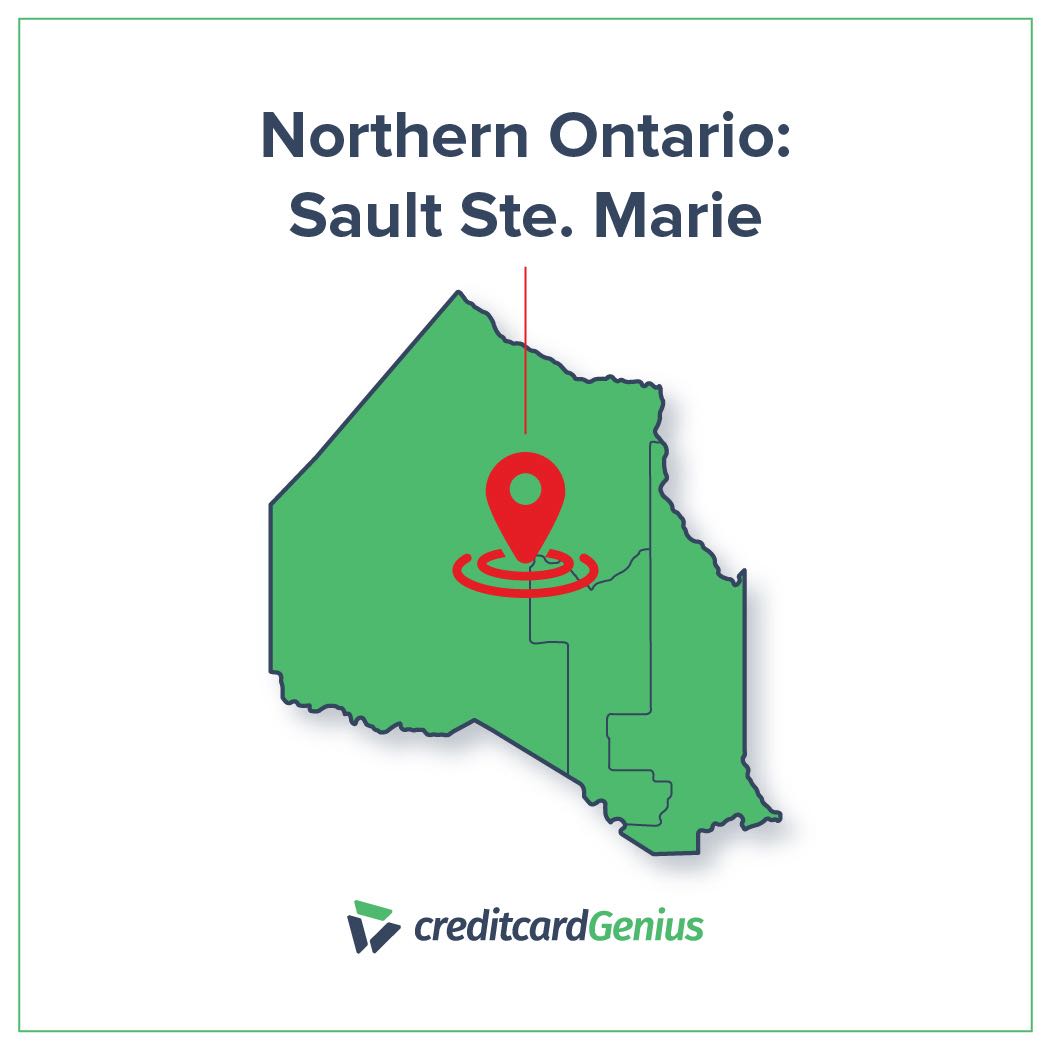
Covering more than half the province, Northern Ontario is a rugged, wild oasis for outdoor sports enthusiasts. Tourists come to canoe, fish, hike, kayak, and more among old-growth forests and over 2,000 miles of groomed snowmobile trails.
But for residents, the region’s cheap transportation costs are the real draw. Thanks to the small population, car insurance costs are low, and Northern Ontario’s cost of living is about 1% less than the national average and 5% less than the provincial average.
The towns of Dryden, Hearst, and Kenora have the cheapest costs of living (6% below national average) while Timmins has the cheapest house prices ($296,0005, on average). The most expensive place to live in Northern Ontario is Sudbury, where it costs an average of $900 – $1,600/month to rent and $478,300 to buy.
Cheapest place to live: Sault Ste. Marie
Population: 64,923
Average house price: $304,700
Average rent: $700 – $1,100
Cost of living: 0% above the national average, 4% below the provincial average
"The Soo" has a population of 64,923 and a direct bridge to its sister city in Michigan, making it well-connected and well-stocked with education, employment, and entertainment. Sault Ste Marie also has the second-shortest average work commute in Ontario and fewer roads, making it an excellent place to pursue a relaxed pace of life.
2. Southwestern Ontario
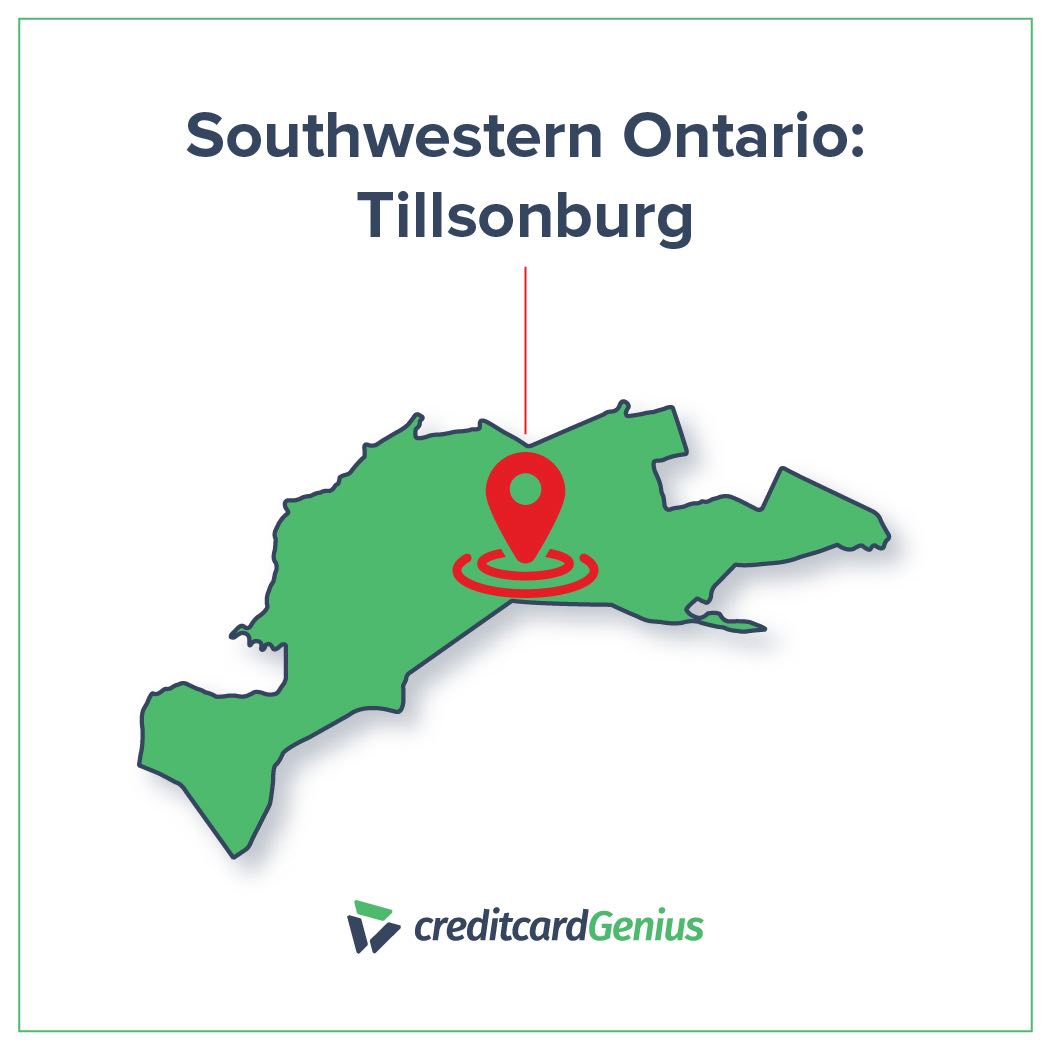
Lined with freshwater beaches and full of farmers’ fields and small towns, the Southwest offers more living places than any other region in Ontario. Food is cheap and true isolation is hard to find. If you want a change of scenery, just hop on a highway and enter the States through Sarnia or Windsor.
Dwindling supply, high demand, and skyrocketing prices have produced an extremely tough housing market in Southwestern Ontario. The average house cost $560,588 in May 2024, which only Chatham, Leamington, and Sarnia can beat at $427,636 – $549,429.
Cheapest place to live: Tillsonburg
Population: 18,573
Average house price: $592,000
Average rent: $900 – $1,100
Cost of living: 4% below the national average, 8% below the provincial average
Property is cheaper in Chatham and Leamington but cost of living and rent is higher.
"Tillsonburger" boasts churches, clubs, a library, museum, senior center, and a community garden, as well as a rapidly-developing downtown core. The Tillsonburg Town Centre Mall is a shopping destination for the county, and there’s a town-wide job board full of openings for new residents.
3. Algonquin Park, Muskoka, and Parry Sound
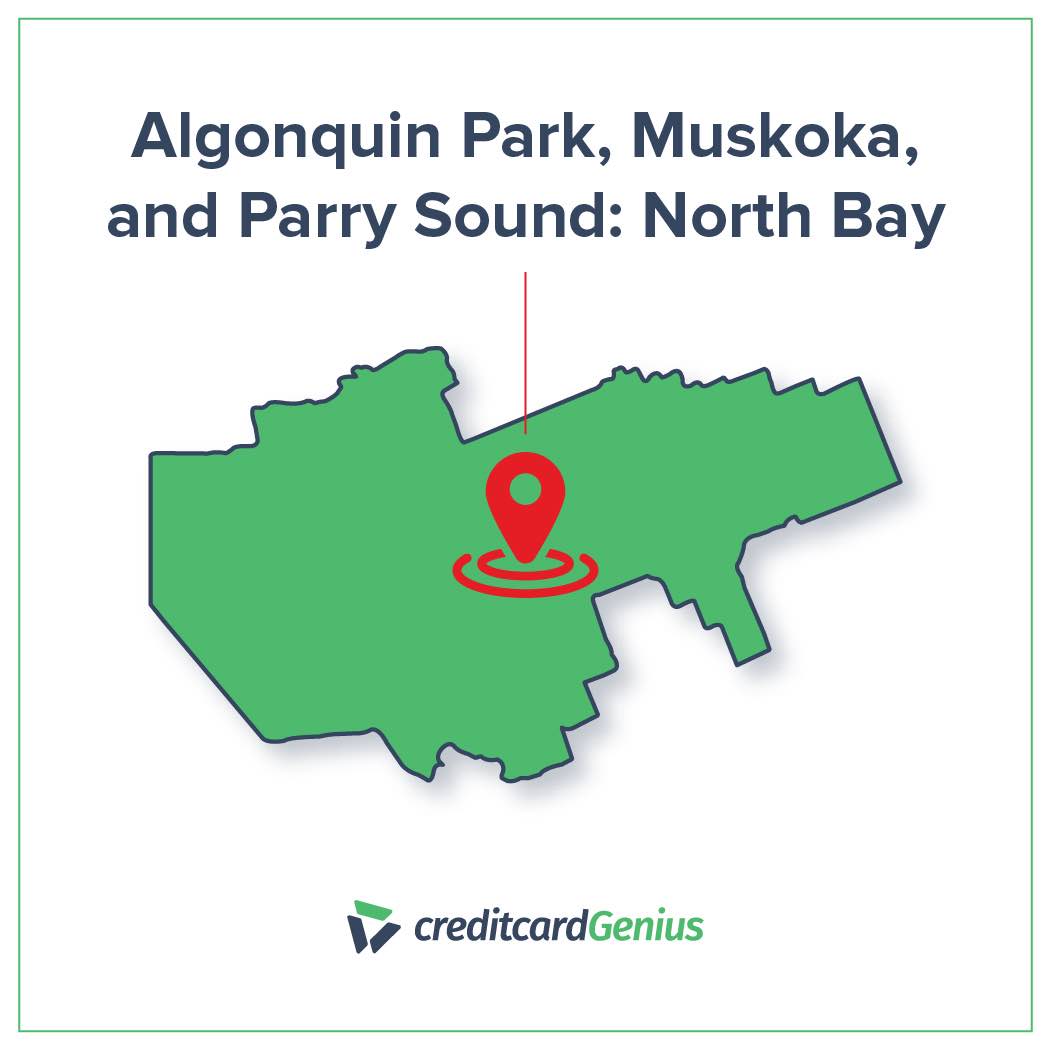
The Northeastern edge of Georgian Bay is "Ontario cottage country," with the upscale chalets, lodges, and resorts to match. Thanks to its close proximity to the fields of Southwestern Ontario, food is fairly cheap, but there are few large towns or amenities and services available.
Waterfront property is highly desirable and expensive. If you go house hunting in Parry Sound (the top runner-up) expect prices in the neighborhood of $500,000 or more.
Cheapest place to live: North Bay
Population: 51,433
Average house price: $423,300
Average rent: $700 – $1,400
Cost of living: 2% below the national average, 6% below the provincial average
As the largest town in the region, North Bay may have a higher cost of living than Parry Sound, but it also has more than 6 times the population. Originally a canoe stop and then a railroad stop, today’s North Bay attracts educators, government staff, healthcare workers, minors, and travellers on the Trans-Canada Highway.
4. Haliburton Highlands to the Ottawa Valley

The "Ontario Highlands" are shot through with waterways and highways, both leading to adventure. Compared to others, the Haliburton region has fairly affordable housing and food, although it costs 6% more than the national average to live in Carleton Place.
Cheapest place to live: Pembroke
Population: 16,571
Average house price: $400,000
Average rent: $800 – $1,100
Cost of living: 5% below the national average, 9% below the provincial average
"The Heart of the Ottawa Valley" was first settled in the early 1800s, a period you can revisit at the Upper Ottawa Valley Heritage Center and during the Old Time Fiddling and Step Dancing Festival in September. Pembroke has at least one of everything – an arts centre, a hockey club, a hospital, multiple schools – making it an excellent home for a variety of families.
5. Kawarthas and Northumberland
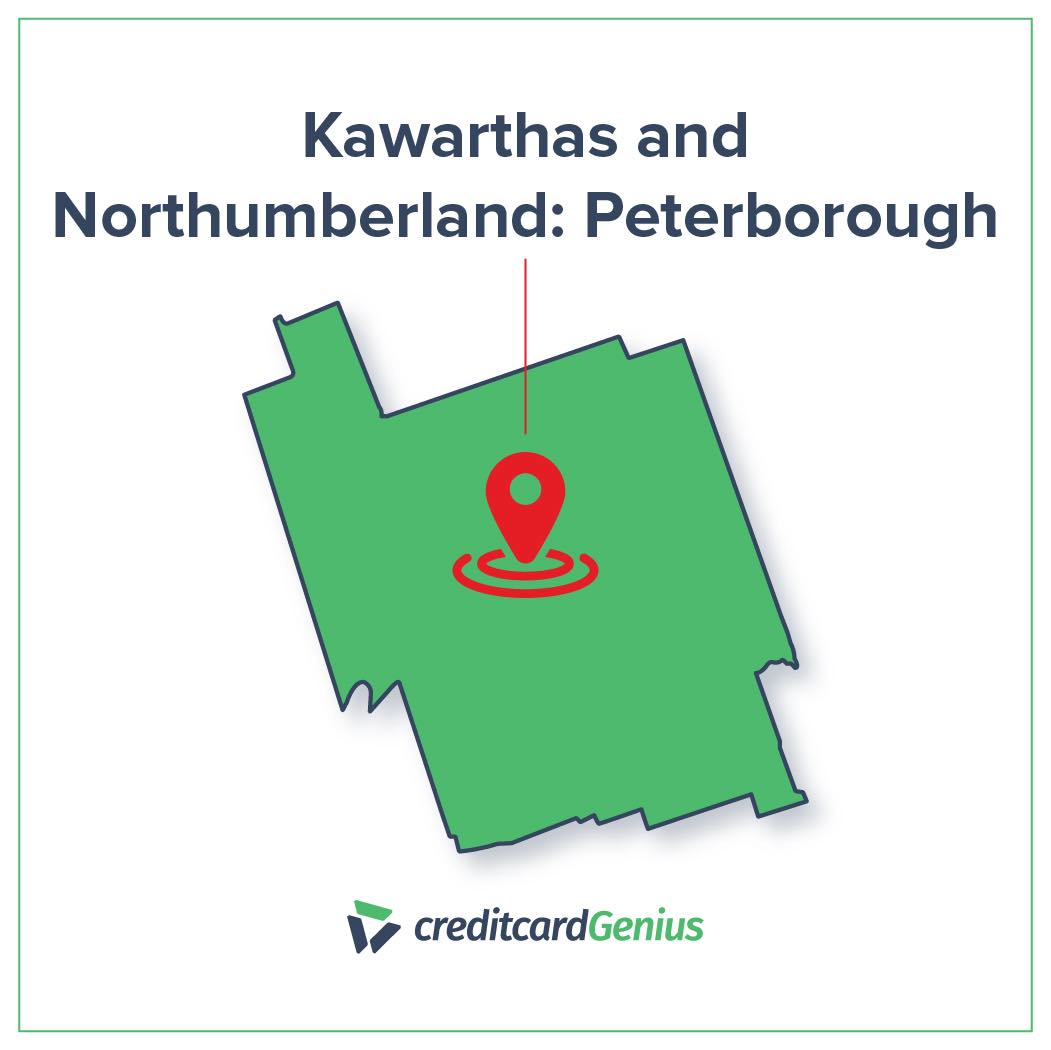
The Kawarthas is a lake and river-studded region just outside Toronto with cheap food and transportation. The average house price reflects its popularity: buyers paid about $654,900 per property in Brighton in May 2023, while buyers in Port Hope forked over $750,000.
Cheapest place to live: Peterborough
Population: 84,793
Average house price: $691,900
Average rent: $900 – $1,700
Cost of living: 4% above the national average, 1% below the provincial average
Sitting at the gateway to cottage country, Peterborough employs plenty of workers in the hospitality and tourism industry. While Brighton has slightly cheaper housing and cost of living, Peterborough features 3 large shopping centers, a Regional Health Centre, and Trent University, making it our top choice.
6. Niagara Region
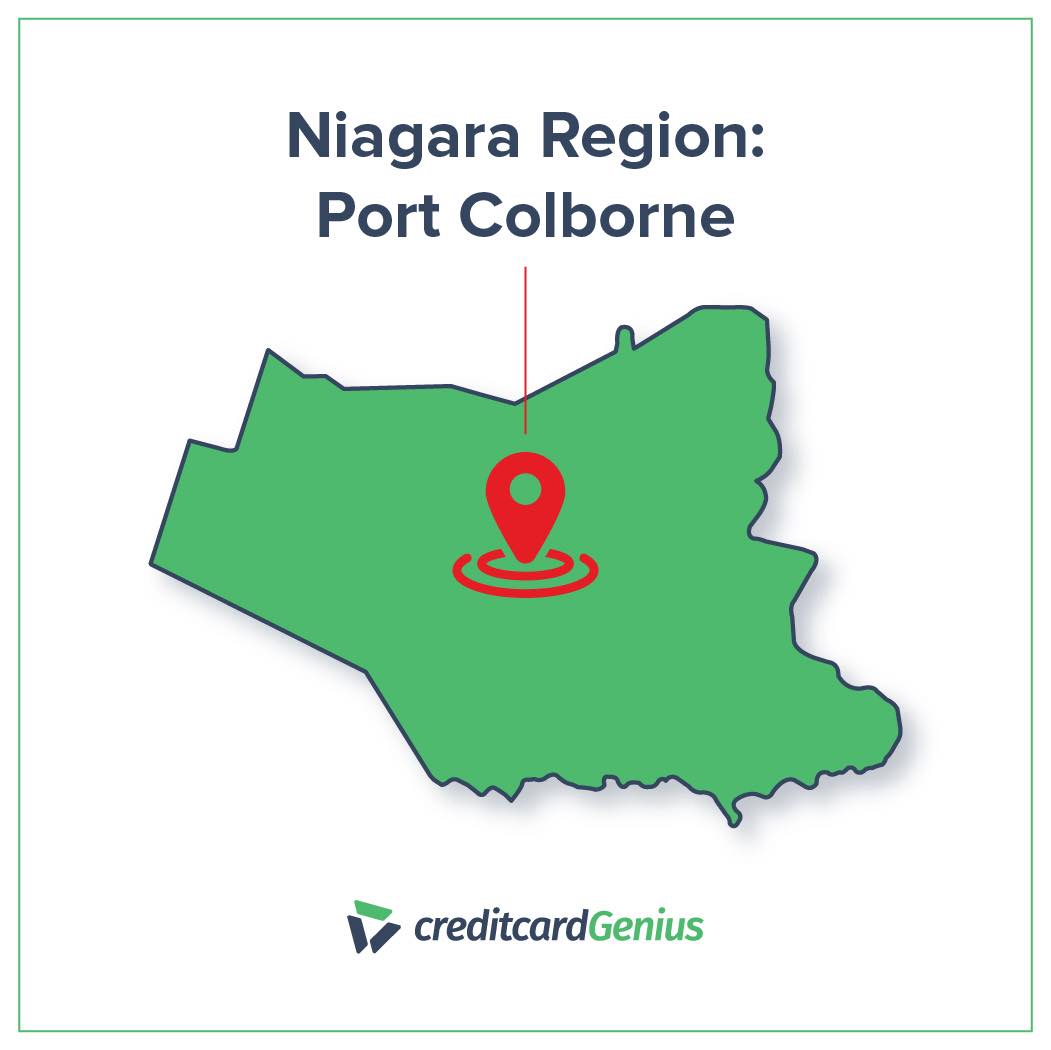
The Niagara Region’s fresh produce, incredible vineyards, and jaw-dropping Horseshoe Falls are a big draw for tourists and residents alike. Health care is cheap, services are plentiful, and Buffalo is only a short drive away – the only thing in short supply is peace and quiet.
Prices are highest in St. Catharines and Niagara Falls – where houses sell for an average of $653,900 each and apartments range from $900 – $1,600 per month – followed by Grimsby and Fort Erie.
Cheapest place to live: Port Colborne
Population: 15,441
Average house price: $530,000
Cost of living: 3% below the national average, 7% below the provincial average
Port Colborne trades in boats and beaches; its biggest attractions include the Historical Marine Museum, Sugarloaf Harbour Marina, and the Welland Canal. But there’s plenty more for residents to discover, like affordable housing, galleries, theatres, an urgent care medical centre, and bus service to Buffalo, Hamilton, and Toronto.
7. Southeastern Ontario
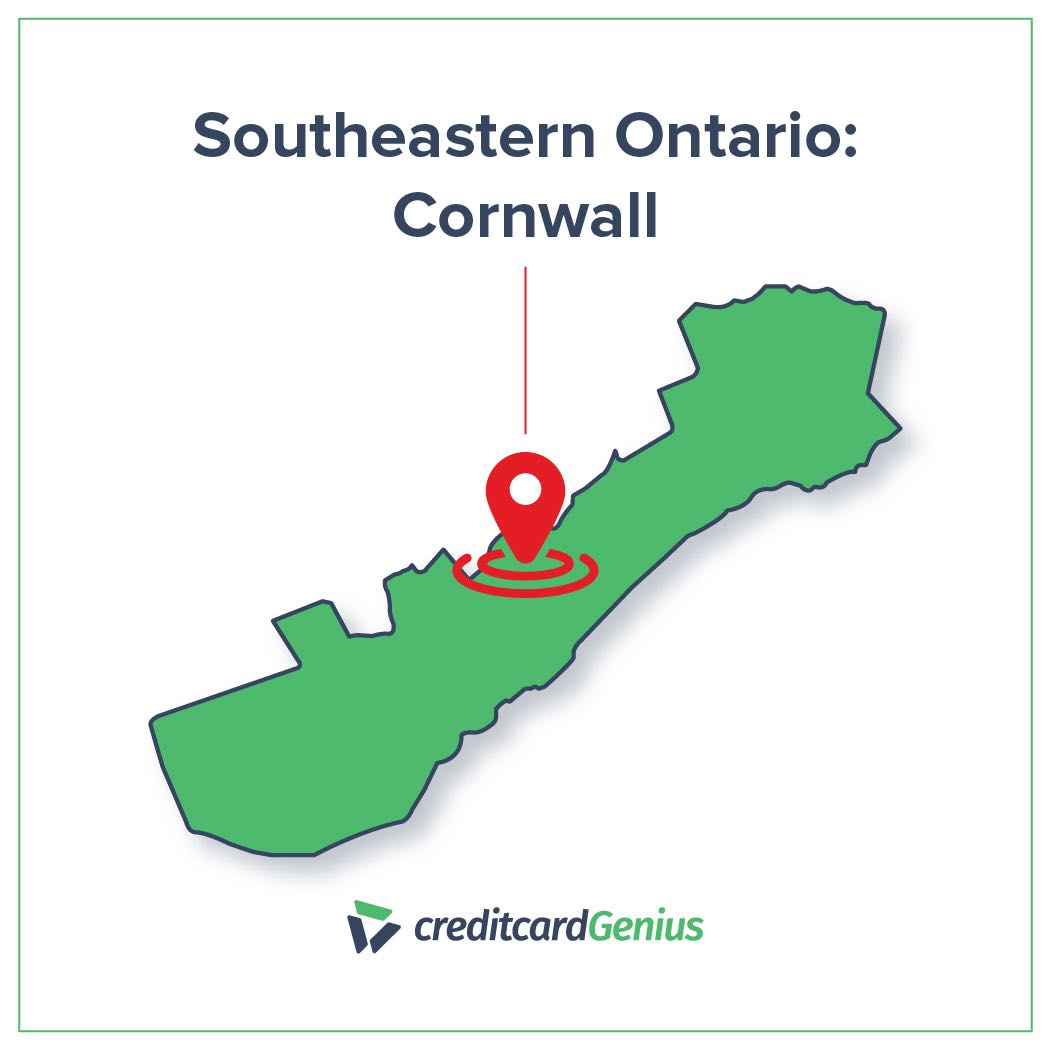
The scenic Southeastern Ontario region follows the St. Lawrence river nearly to Montreal. Despite its population density and easy access to the 401, the cost of living in this region matches the national average and costs 2% less than the rest of Ontario.
Belleville and Kingston tie for the most expensive places to live in the southeast. The average house costs $559,000 – $592,600, the average rent runs $900 – $2,000, and the cost of living is 7% higher than the national average.
Cheapest place to live: Cornwall
Population: 47,286
Average house price: $383,147
Average rent: $800 – $1,500
Cost of living: 2% below the national average, 6% below the provincial average
Cornwall’s position next to the 401 makes it the ideal location for a distribution centre for many large retailers. It boasts a variety of cultural attractions – including a gallery, library, museum, and theatre – plus 3 ice rinks, 2 indoor arenas, and hockey, rugby, and soccer teams.
8. Bruce, Grey, and Simcoe
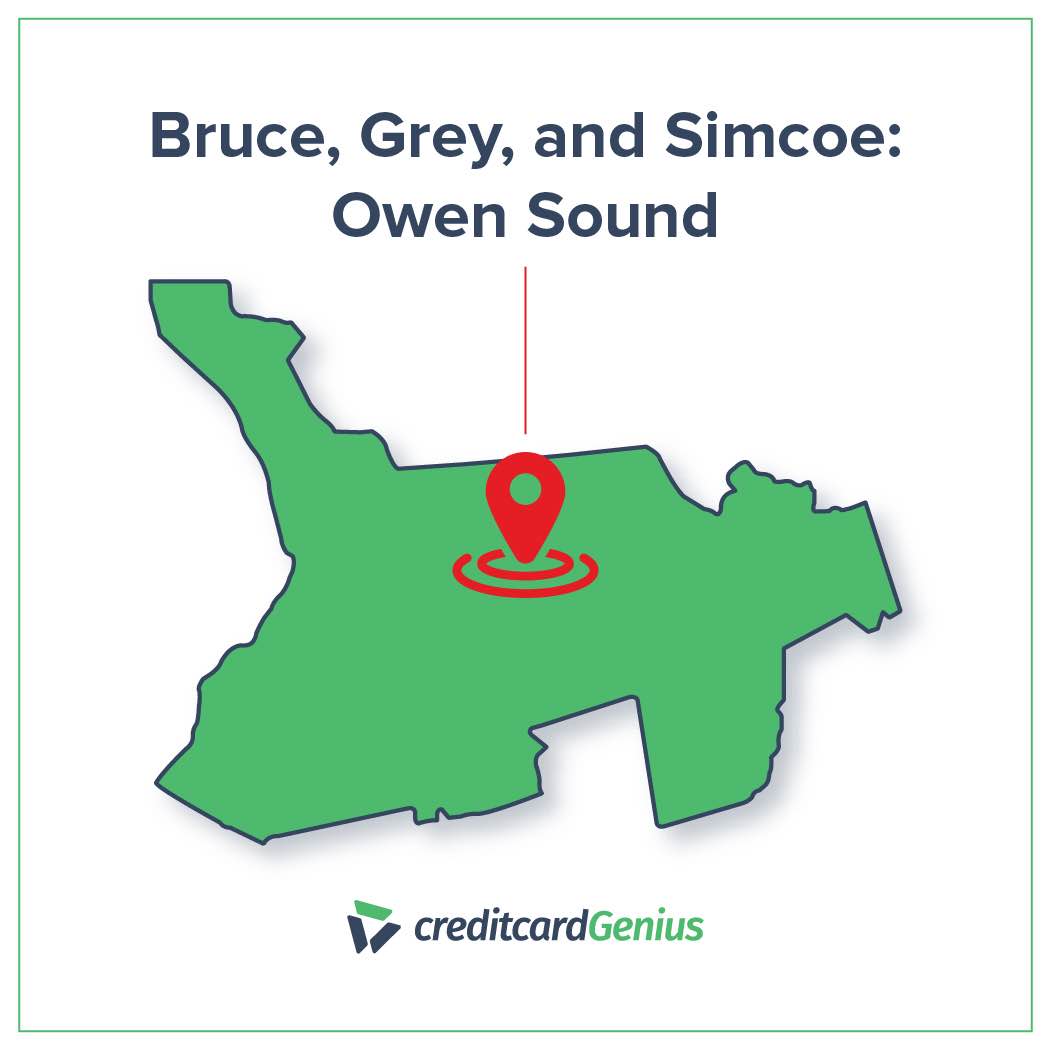
Encompassing the Bruce Peninsula and a slice of the Georgian Bay shoreline, the Bruce, Grey, and Simcoe area is full of caves, camping spots, orchards, and sandy beaches. Food costs are below the national average but most towns have a large enough population to support a decent variety of services.
The closer you get to the lake, the higher the price of housing. The most expensive towns are Barrie and Collingwood, where it costs an average of $1,000 – $1,800 to rent and $741,932 – $807,300 to buy.
Cheapest place to live: Owen Sound
Population: 22,318
Average house price: $570,900
Average rent: $800 – $1,200
Cost of living: 4% above the national average, 1% below the provincial average
Owen Sound has become a popular retirement community thanks to its many cultural, natural, and recreational attractions. It hosts all the essentials – education, government offices, health care, etc. – plus unique offerings like the Summerfolk Music and Crafts Festival, the Festival of Northern Lights, and the Novel Marathon.
9. Huron, Perth, Waterloo, and Wellington
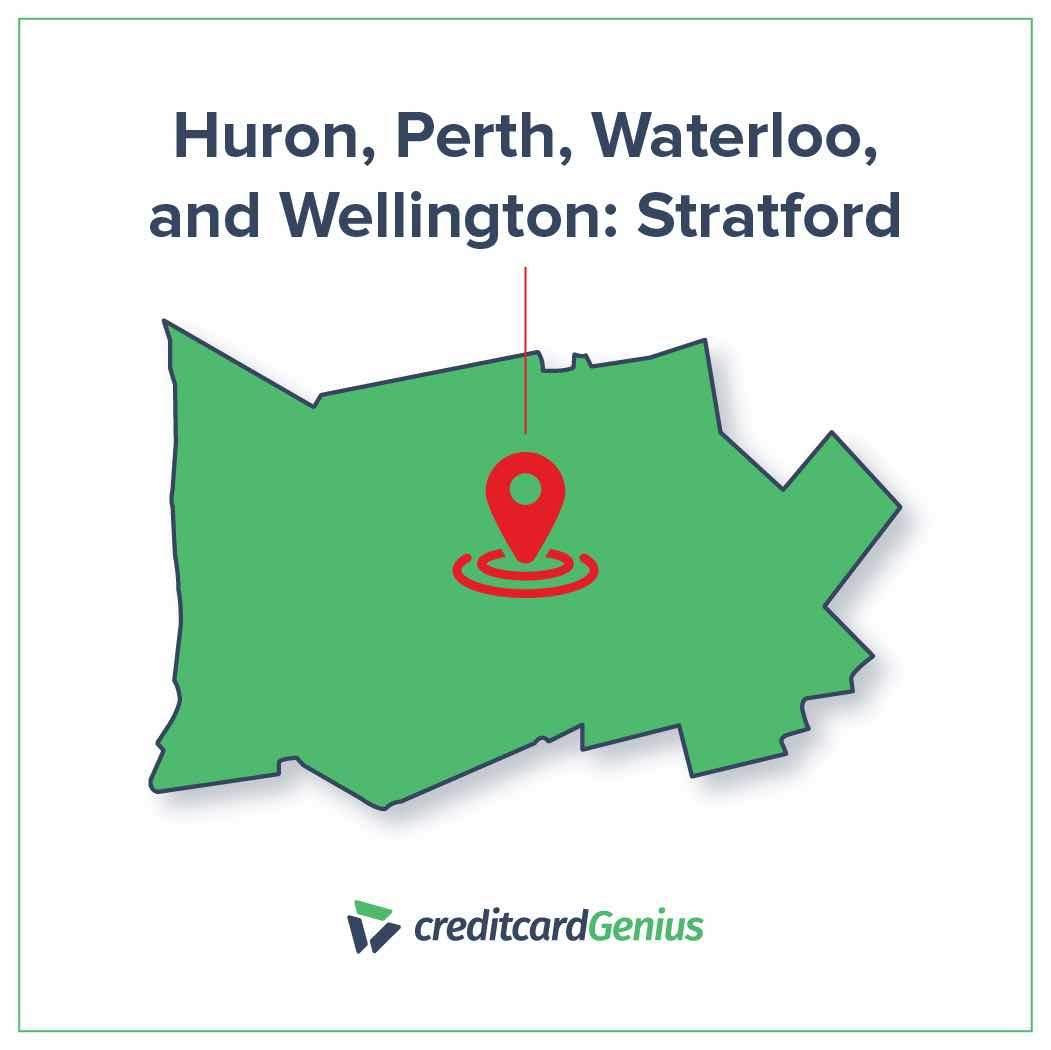
Mostly rural and rich in heritage, you can find homegrown veggies, home-baked pies, and handmade crafts for sale when you drive through Huron, Perth, Waterloo, and Wellington counties.
While health services remain accessible and affordable, the average house costs about $820,000 in Guelph and the average rent ranges from $1,100 – $2,200 in Cambridge and Kitchener. Smaller towns like Fergus and New Hamburg have lower costs of living, but in the absence of hard housing data, we’ve crowned Stratford the winner.
Cheapest place to live: Stratford
Population: 32,878
Average house price: $677,000
Average rent: $1,000 – $1,500
Cost of living: 7% above the national average, 3% above the provincial average
The Festival City is all about tourism. Its most famous attraction, the Stratford Festival, celebrated its 70th season in 2023, and most of its economy revolves around the arts, culture, hospitality, and restaurants. While there’s no easy access to the 401, Stratford has its own VIA Rail train stop and gathers plenty of fresh produce from the surrounding farmlands.
10. York, Durham, and Headwaters
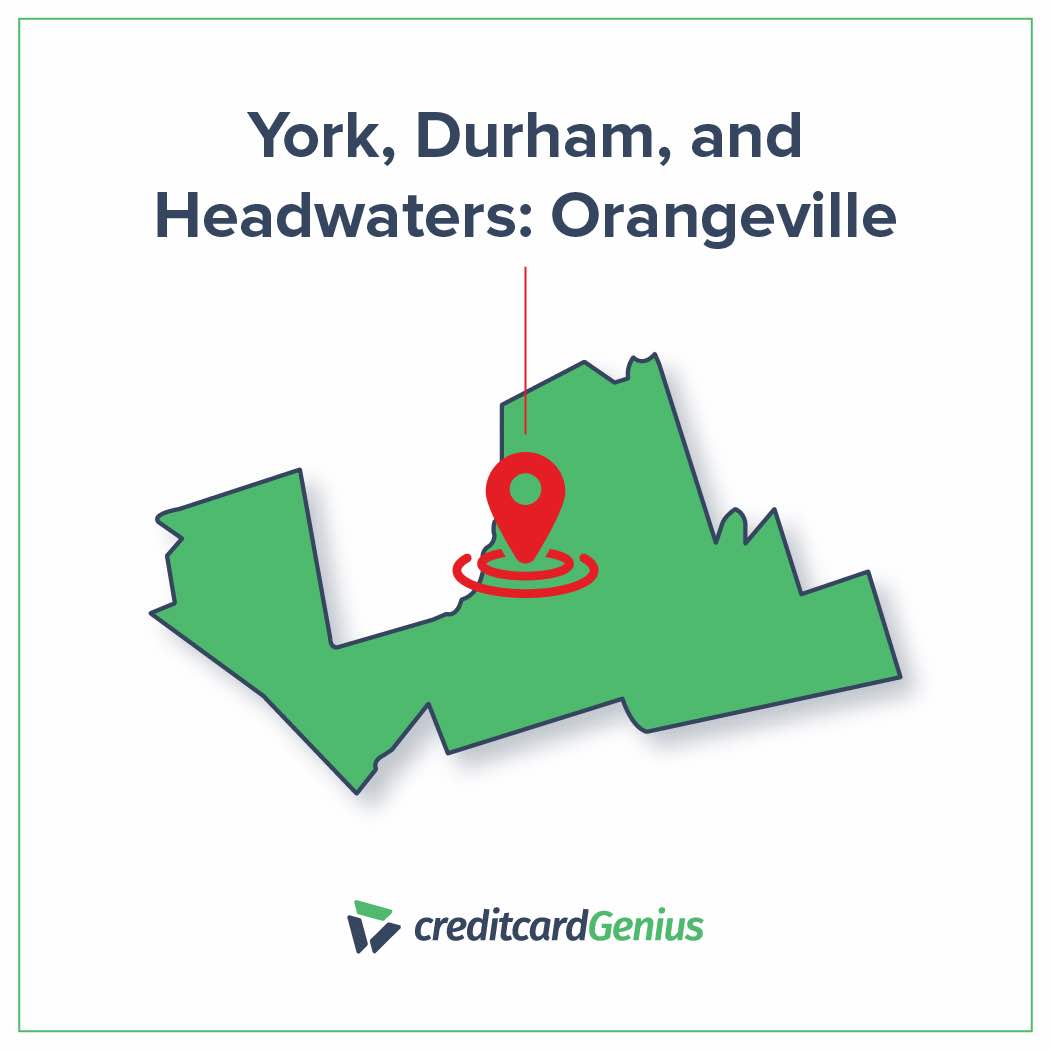
The York, Durham, and Headwaters region straddles both the Greater Toronto Area and cottage country, making it a great pick for both family homes and vacations. If you require access to the big city, but prefer a laid back atmosphere, be prepared to pay – it costs an average of 14% more to live here than in the rest of the nation.
Cheapest place to live: Orangeville
Population: 34,177
Average house price: $813,021
Cost of living: 8% above the national average, 3% below the provincial average
Shelburne may have cheaper housing, but for a nominal price increase, you can have 3 times more neighbors and services. Orangeville is the administrative, commercial, and shopping hub of Dufferin County and offers a variety of public schools for young families looking for a place to grow.
11. Ottawa Region
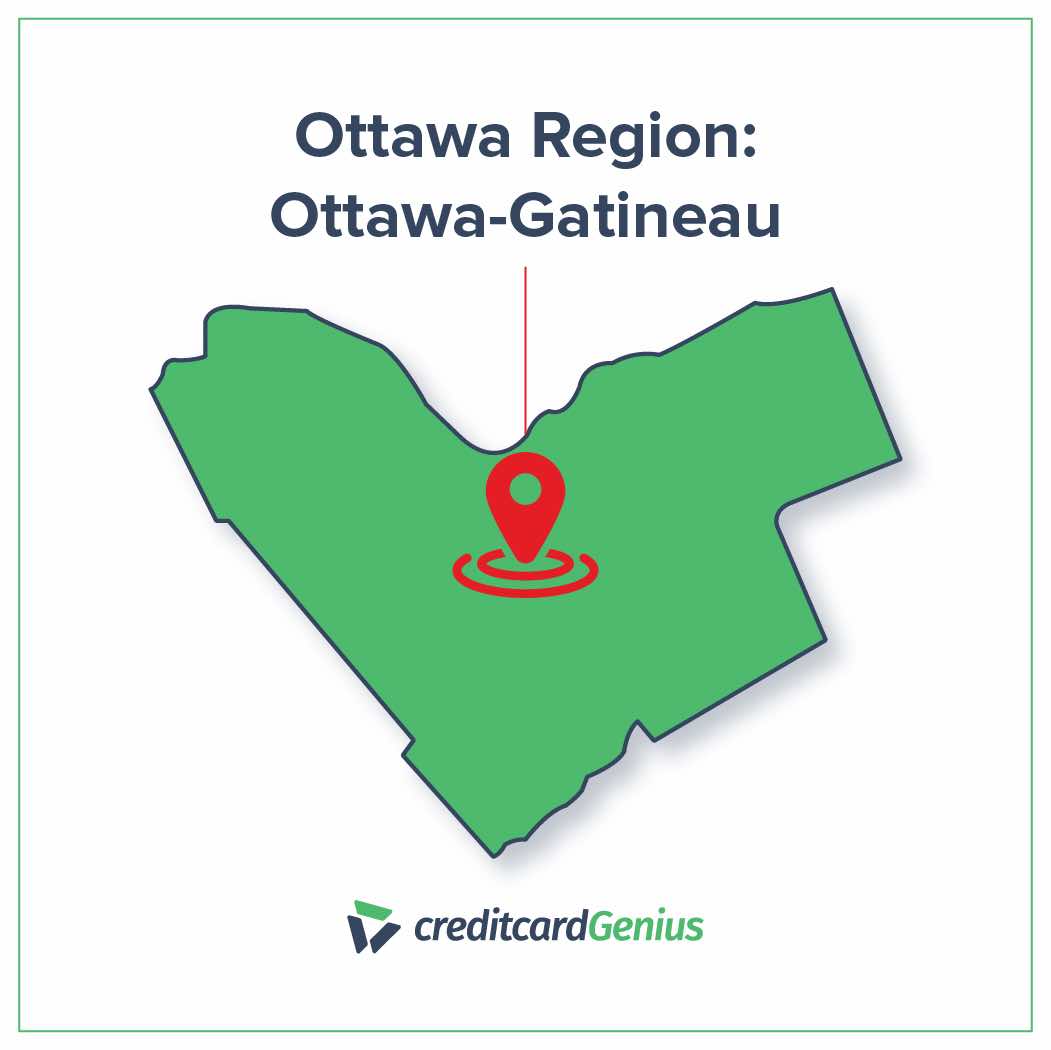
The small, urbanized region around the country’s capital city employs thousands of Canadians in the arts, culture, hospitality, service industry, tourism, and – of course – government. The cost of so much variety is a 22% premium on the national average cost of living.
Cheapest place to live: Ottawa-Gatineau
Population: 1,068,821
Average house price: $651,300
Average rent: $1,100 – $2,100
Cost of living: 22% above the national average, 17% above the provincial average
Ottawa is the regional winner by default, but it ain’t cheap. Houses cost an average of $651,300 while rent costs about $1,100 – $2,100 per month. For their troubles, residents enjoy unparalleled access to the nation’s premier artistic, cultural, educational, and technological treasures.
12. Hamilton, Halton, and Brant
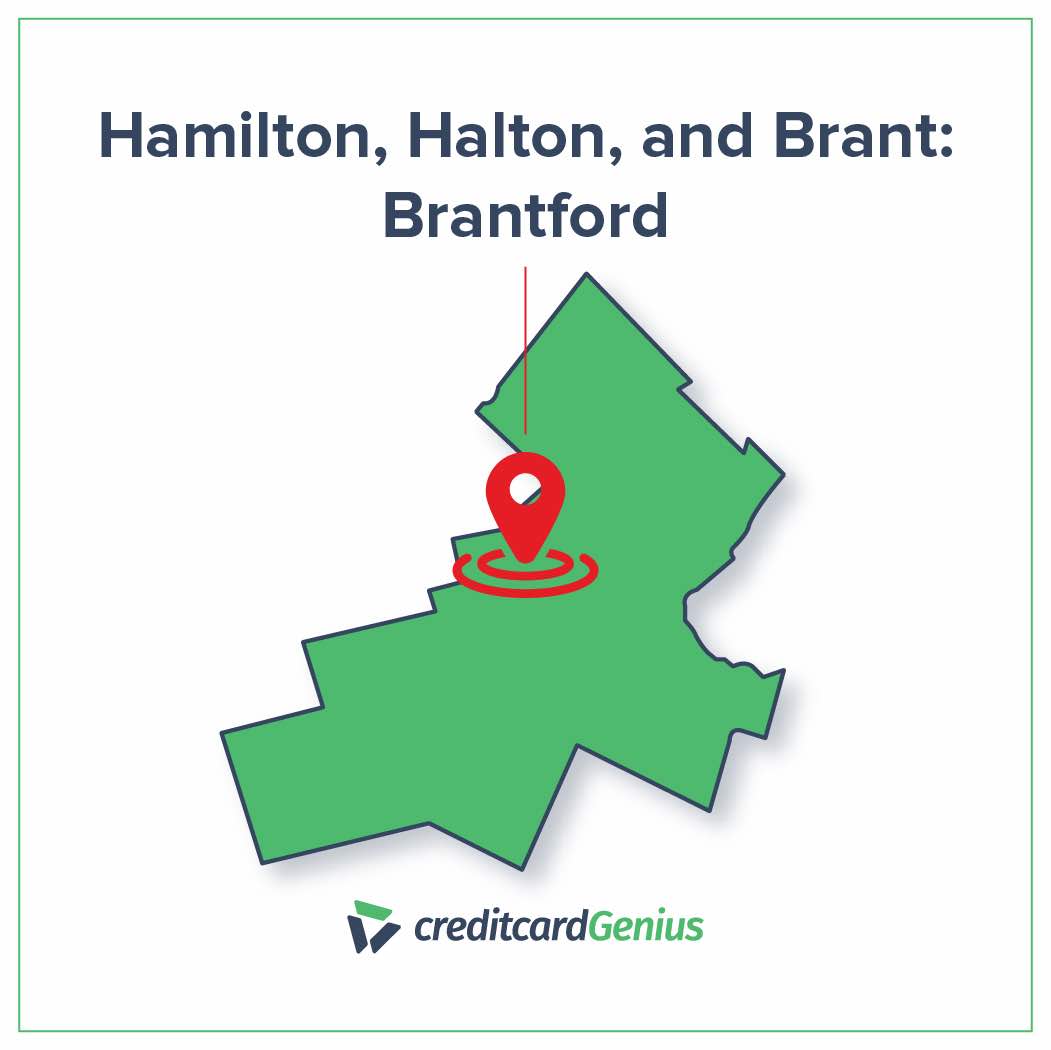
"The Heart of Ontario" is rich in natural features like the Bruce Trail, the Heritage Grand River, and the Niagara Escarpment. But it costs an average of 22% more than the national average to live in Hamilton, Halton, and Brant.
The worst culprits are Burlington and Oakville, which demand a 25% cost of living premium and an average house price over $1.5 million. Rent is no better, ranging from $1,000 – $1,700 in Hamilton.
Cheapest place to live: Brantford
Population: 104,413
Average house price: $674,200
Average rent: $1,000 – $1,500
Cost of living: 11% above the national average, 6% above the provincial average
Brantford is home to several manufacturing plants, schools, and a thriving film, radio, and television industry. Its affordability may be due to the fact that it lies on the western edge of the region; the cities closest to the shore are also the most expensive.
13. Greater Toronto Area
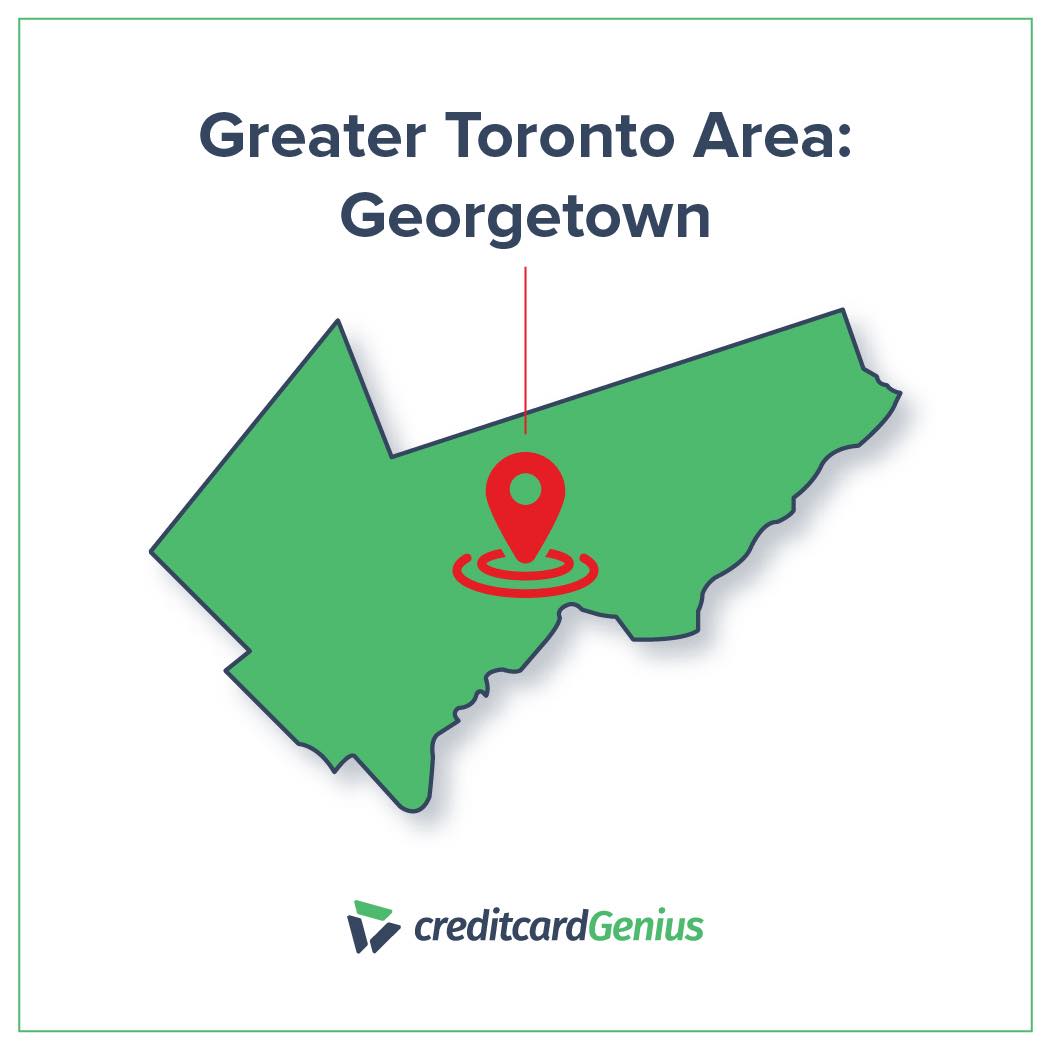
Like the Ottawa-Gatineau region, the GTA is defined by a single major metropolis. Toronto boasts the biggest population in Canada and 5 of everything you could want.
The cost of living in a major film, food, finance, and technology hub is an average house price of $1,117,400, and expenses that are 28% higher than the national average and 23% higher than the provincial average.
Cheapest place to live: Georgetown
Population: 44,058
Average house price: $1,102,400
Cost of living: 7% above the national average, 2% above the provincial average
The most expensive cheapest place to live in Ontario is a small community north of Mississauga. Thanks to its proximity to Toronto, Georgetown’s housing prices remain high but its cost of living is comparatively low. Residents also enjoy access to fairs, festivals, farmers’ markets, schools, and employment among the many offices that want to stay near the big city without paying high rent.
How we got our data
To find the 13 cheapest places to live in Ontario, we turned to:
- Statistics Canada for how most Canadians spend their money and average rent prices in various cities from 2019 – 2023
- The Canadian Real Estate Association, WOWA, and Houseful for the average price of a house for sale by city in May 2024
- Tourism Ontario for an outline of each of the 13 regions of Ontario
- The Economic Research Institute (ERI) for the average national, provincial, and municipal cost of living in each area
The regions and places with the cheapest housing prices and costs of living (with enough data to support each point) came first. On occasion, we ranked more expensive places higher to reflect the value of living in a large population center with lots of amenities.
FAQ
What city in Ontario has the lowest cost of living?
In Hearst, ON, most living expenses cost 6% less than the national average and 9% less than the provincial average.
Where are houses cheapest in Ontario?
The cheapest real estate is in Dryden, ON, where the average house cost $238,000 in April 2024.
Where are home prices falling the most in Ontario?
A recent survey of the 67 largest Canadian cities showed that house prices in Burlington fell an average of $163 per day at the end of 2022. Meanwhile, condo owners in Mississauga saw their properties plummet by about $36,600 over the same time period.
Where in Canada has the most affordable housing?
Sault Ste. Marie has the most affordable housing relative to its population, with an average house price of $304,700 and an average rent of $700 – $1,100.
Where is the most unaffordable place to live in Canada?
The most unaffordable city in Canada is Vancouver, where the average house costs over $1 million to buy and the average cost of living is 41% higher than the rest of the nation.
creditcardGenius is the only tool that compares 126+ features of 228 Canadian credit cards using math-based ratings and rankings that respond to your needs, instantly. Take our quiz and see which of Canada's 228 cards is for you.



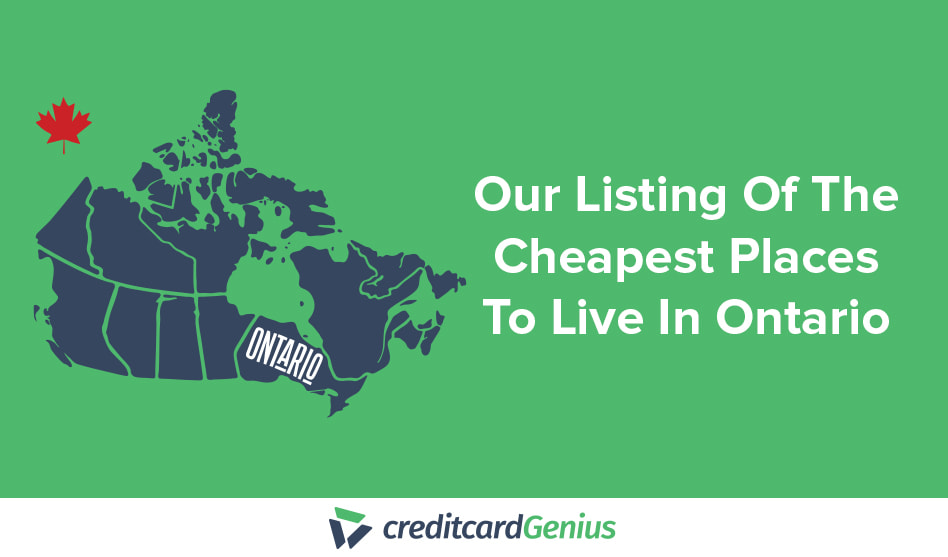


 GC:
GC: 



































 $100 GeniusCash + Earn up to 15,000 Welcome Bonus Membership Rewards® Points.*
$100 GeniusCash + Earn up to 15,000 Welcome Bonus Membership Rewards® Points.*
Comments
Leave a comment
Required fields are marked with *. Your email address will not be published.
Showing 4 comments